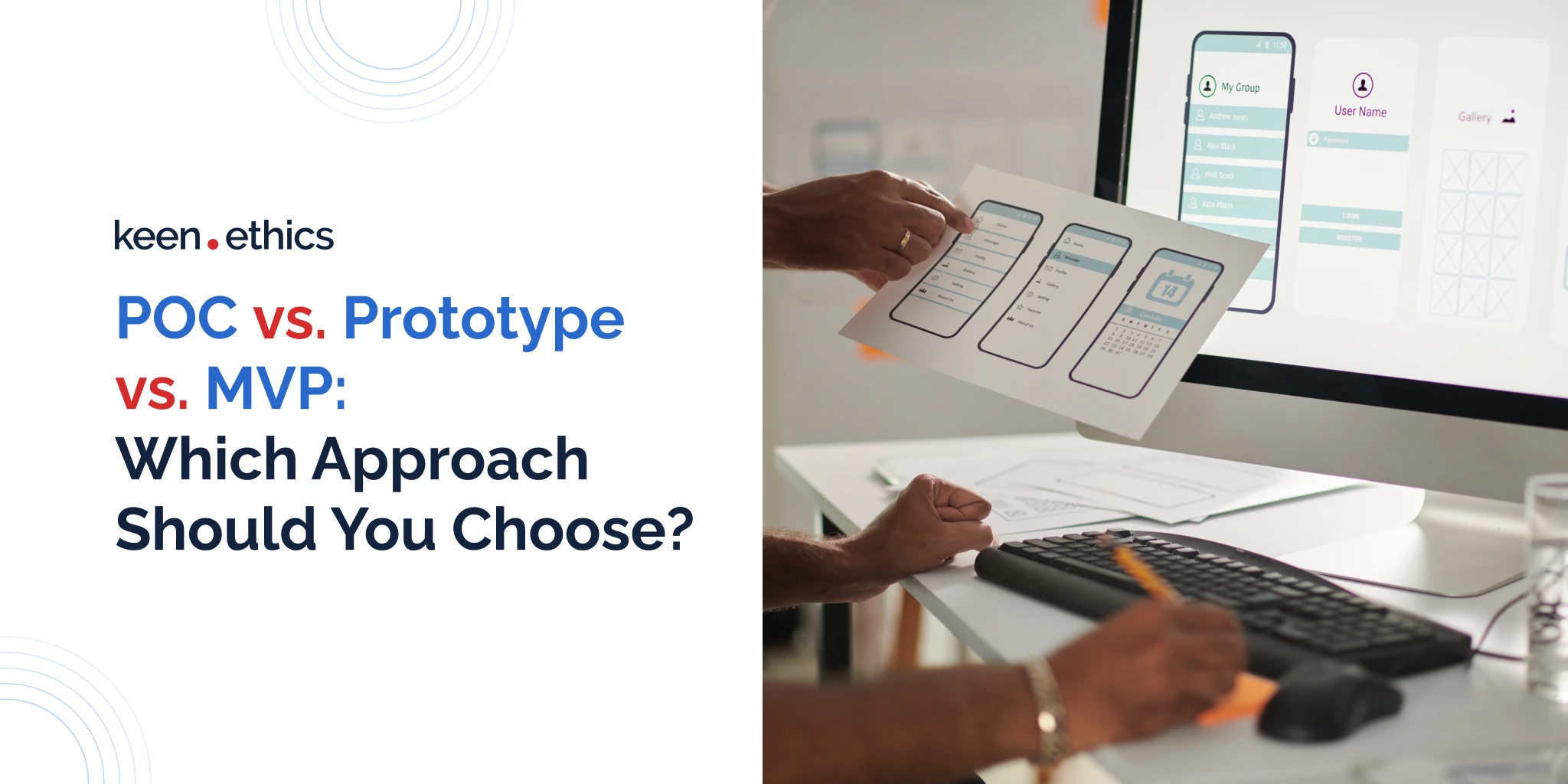Multiple frameworks for testing business ideas exist in the IT field. We’ll review all these approaches and offer detailed insights into them.
A major mistake for many newcomers to the software market is an immediate transition to active development. Some individuals and even businesses proceed with an immediate full-scale version of their product without considering its viability. Occasionally, the ‘gamble’ pays off, and the average users get access to a high-quality project. Often, however, it fails, leading to avoidable financial losses. What should one do to escape this problem? We recommend investing in procedures allowing one to test the overall feasibility of their business ideas. This article analyzes the viability of POC (proof of concept) vs. MVP (minimum viable product) vs. prototype. We’ll look at the definitions of the presented frameworks and then transition toward analyzing the benefits and negatives such approaches can bring about to their users.
POC vs. Prototype vs. MVP: What’s the difference?
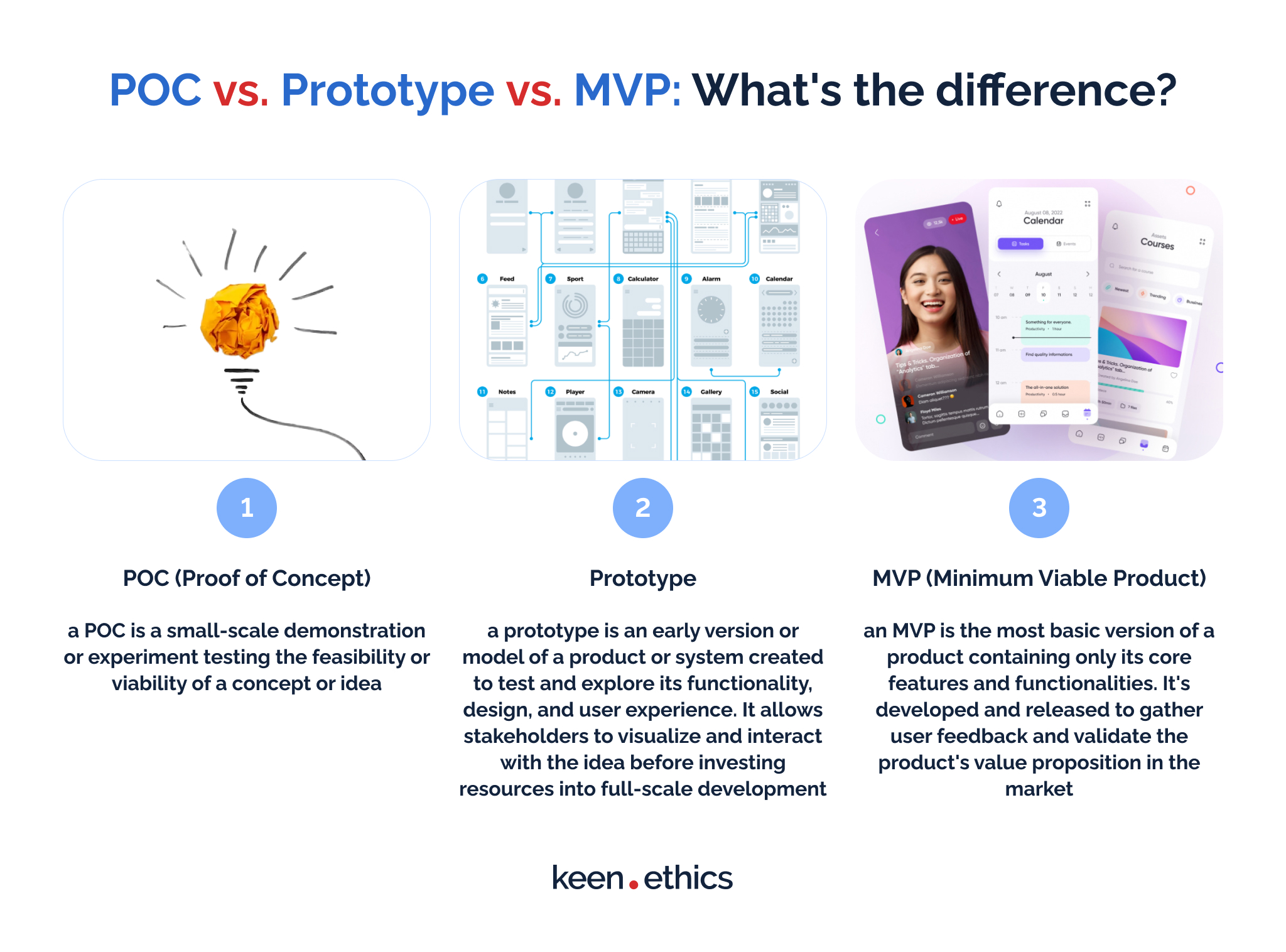
To understand the differences between the presented terms (POC vs. prototype vs. MVP), let’s start by looking at their definitions:
1) POC (Proof of Concept): a POC is a small-scale demonstration or experiment testing the feasibility or viability of a concept or idea. It aims to validate if a certain technology, approach, or design can work as intended.
2) Prototype: a prototype is an early version or model of a product or system created to test and explore its functionality, design, and user experience. It allows stakeholders to visualize and interact with the idea before investing resources into full-scale development.
3) MVP (Minimum Viable Product): an MVP is the basic version of a product, containing only its core features and functionalities. It’s developed and released to gather user feedback and validate the product’s value proposition in the market. The MVP helps to minimize initial development costs and enables iterative improvements based on user input.
As you may see from those definitions, the differences between POC vs. prototype vs. MVP are small. Nonetheless, there’s a clear trend: a prototype is more complex than a POC, and an MVP is more complex than a prototype. The difference between proof of concept vs. prototype is simple: proof of concept involves a small-scale test of one ‘main’ feature; a prototype involves a combination of several features, which is closer to a full-scale product but lacks refinement in overall user experience. Lastly, an MVP is a version of a product offering a release-like experience at a minimum cost. We believe all the presented stages of development are crucial for products aiming to succeed in the modern high-pressure market. In our opinion, only the most well-tested ideas can skip the proof of concept stage.
What is a Proof of Concept?
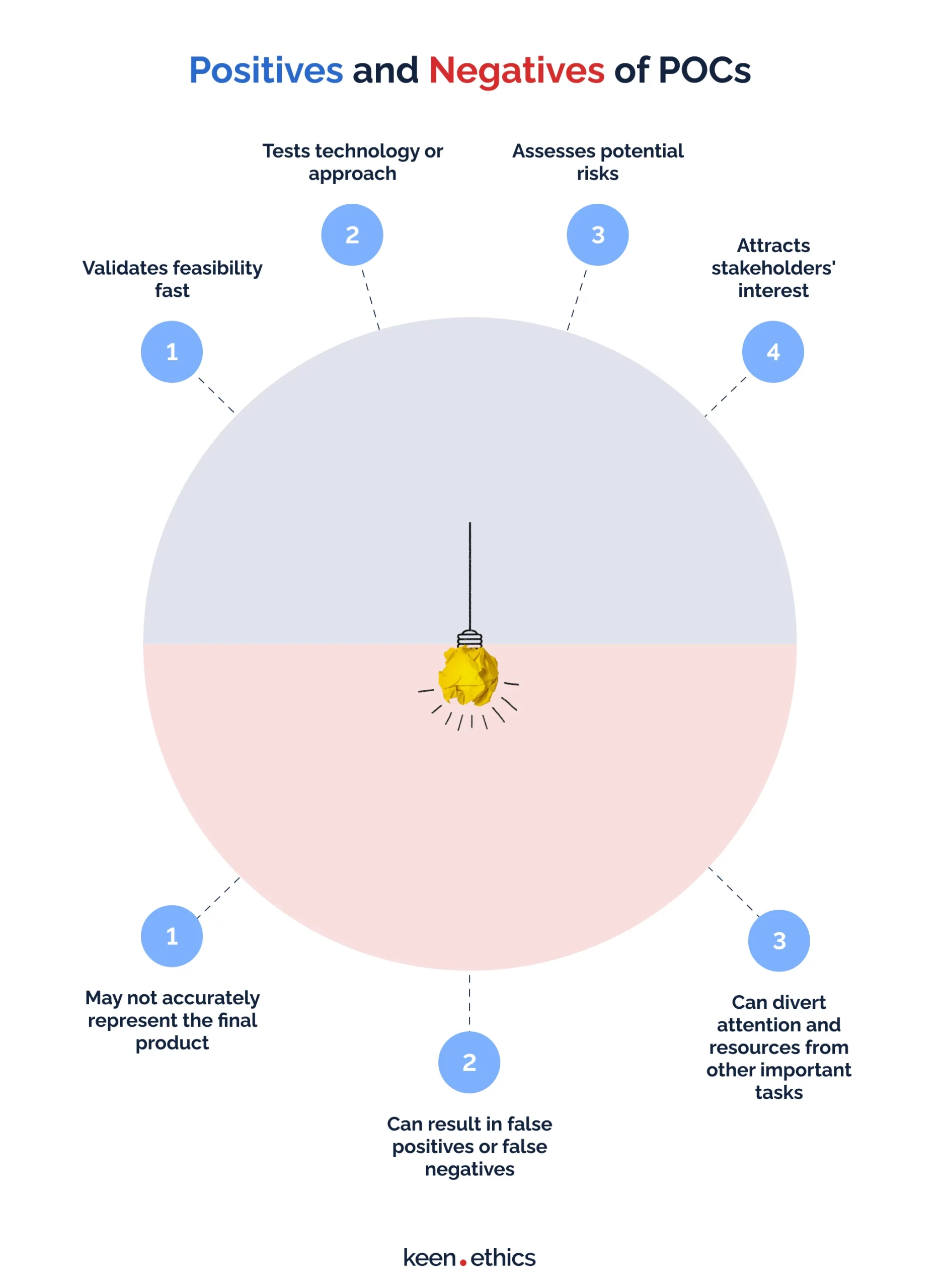
Before we transition to the analysis of the positives and negatives stemming from the POC framework, let’s reiterate the definition of this concept. A POC stands for a small-scale demonstration or experiment testing the feasibility or viability of a concept or idea. So, what are the positives and negatives of such frameworks? Let’s review them!
POC positives
Here are the key positive aspects of POCs:
- Validates feasibility fast
The key reason to use a proof of concept vs. prototype is to see if your idea makes sense at a minimum cost. While a prototype may require several weeks of development (which are often not cheap), a POC takes several days or a week at best. This way, you can understand if your idea is worth further attention quickly. Speed is the key factor in the modern business world; POC guarantees the ability to react to certain trends efficiently.
- Tests technology or approach
POCs are great not only for the review of novel business ideas but also for the analysis of certain technologies. A POC is a great option even if you don’t have an innovative idea per se but want to realize an already existing concept in a new framework. A POC shows if a certain technology (especially if it’s new) can be feasible in your use case. Many options exist on the market, and a prototype for them makes no sense. Proof of concept vs. prototype choice, however, is a much better approach to spreading your resources.
- Assesses potential risks
Many concepts that seem great on paper tend to have unexpected negative effects. As Karl Popper once said, it’s impossible to predict the technological development of humankind and its consequences. For instance, many people used to think AI is a risk primarily for blue-collar professions. The current generative language model revolution will most likely bring about major risks for white-collar jobs, according to Madison Hoff and their colleagues at the Insider. The presented problem is valid for many ideas. Why do we need POCs? They offer an opportunity to see if your logic regarding certain technology works well. You can see the real risks of an idea rather than some subjective predictions. There’s no better way to prove the danger of certain frameworks than reality itself.
- Attracts stakeholders’ interest
A common misconception regarding investment is that marketing is a crucial factor in attracting investors’ attention. The reality is very different: people are getting increasingly skeptical of products that don’t deliver immediate showcases of their functionality. The examples of firms such as Theranos (as reported by BBC) and many failed projects on Kickstarter (as reported by Failory) teach many investors that they should demand proof of concept before investments. A POC is a key way to attract stakeholders’ interest, as long as you’re competent enough to present your idea in clear and understandable language. Show an idea that genuinely works, and people will pay attention to your business plans.
POC negatives
POCs also have some major negatives for the users:
- May not accurately represent the final product
A proof of concept is a great way to understand if an idea is feasible. The problem is that no product can organize itself along one central idea. One has to add multiple features to guarantee comfort. What’s the catch here? An idea feasible on the POC level may be problematic at the level of user experience. For example, an achievement system for a banking app may seem feasible from the technical standpoint at the POC stage but meet behavioral problems once it reaches a prototype: many users can find it redundant.
- Can result in false positives or false negatives
What’s the key difference between proof of concept vs. prototype? It lies in the complexity of the software. Proof of concept involves the simplest realization of an idea. In this light, it can mislead the decision-makers by not putting all the key concepts into a strong context. What do we mean by this? Let’s imagine an autocorrecting feature for writing-oriented software. Its proof of concept can work: the code will correct the texts without major issues. However, a prototype can reveal large-scale problems. The feature, for instance, can be annoying for the users because it may lead to false corrections. A prototype vs. proof of concept is crucial here. It can show that having an autocorrect feature isn’t enough: one should also add ways to control it and cancel come corrections in a user-friendly way. Not every idea we produce survives contact with UX-related reality.
- Can divert attention and resources from other important tasks
A big problem of POCs is that they give a perfect framework for procrastination. A developer can simulate ‘work’ by testing different ideas and producing no tangible outcomes due to them failing. Many products have a central feature attracting users. For instance, many people use Google Documents because they offer great collaboration capabilities and minimize the risk of data loss. Google’s Office Suite isn’t as feature-rich as that of Microsoft (Office) or The Document Foundation (LibreOffice). Releasing its desktop version makes no sense: most people need high-quality web capabilities for this platform. Google doesn’t require many POCs for advanced features. It needs to focus on making the web experience as smooth as the desktop-based one.
Proof of Concept: Some real-life cases
Multiple projects are in the proof of concept stage at the current level. Here are the key ideas the market thoroughly tests:
- Autonomous Vehicles: multiple companies in the modern market are investing in analyzing the feasibility of the so-called autonomous vehicles. For example, Tesla and Nvidia are making investments in this sector.
- Virtual Reality Gaming: we know virtual reality games already exist. However, they’re far from the mainstream: the majority of console, PC, and mobile games focus on the keyboard, sensor, and gamepad controls, according to Martin Armstrong at Statista. In the current situation, traditional games have a 44 times larger market than VR ones. Those games prove that one can create a mainstream product of such kind in the future. We’ll need more device productivity to ensure a smooth and accessible experience, but the idea is feasible. Other apps are also possible: with accessible and comfortable devices, VR job-oriented projects like Meta’s may finally become possible.
- Augmented Reality Retail: Retailers developed the proof of concepts to show how augmented reality can enhance the shopping experience by allowing customers to visualize products in their homes before purchasing. We may see the idea come into being within the next several years.
What’s a Prototype?
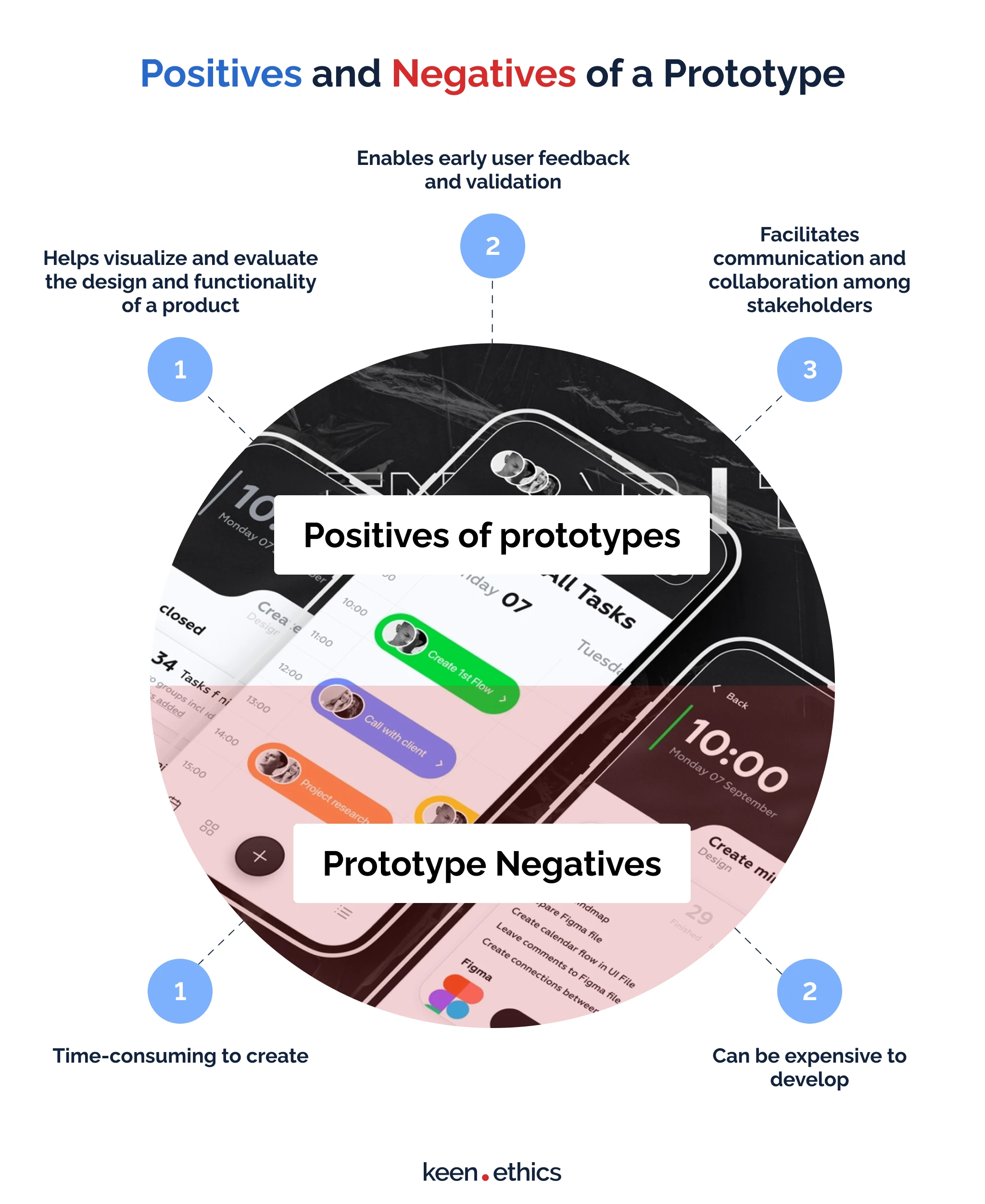
To understand the benefits and negatives of a prototype, it’s crucial to look at the definition of this term first. A prototype is an early version or model of a product or system created to test and explore its functionality, design, and user experience. Now that we know the key aspects, it’s time to transition toward the positives and negatives of this framework.
Positives of prototypes
Prototypes have some significant positives for the average users:
- Helps visualize and evaluate the design and functionality of a product
What’s the key advantage lacking in proof of concept vs. prototype? A prototype delivers the ability to test the idea in a realistic environment. A POC doesn’t have an interface close to the real frameworks. A prototype, however, already possesses enough features to help visualize and evaluate the functionality of a product. With a prototype, you can see if an idea makes sense from a usability standpoint.
- Enables early user feedback and validation.
A good prototype provides an opportunity to engage the potential users of your product in the analysis of an idea. You can give a prototype to some testers, and they’ll be able to use it for real work tasks. In our opinion, nothing helps test ideas better than reality itself. If you can build a strong prototype, your project will likely succeed. For instance, the recent video game hit, Vampire Survivors, started as a prototype product, according to Vice. Now, it has managed to spawn an entire genre, according to gaming publications.
- Facilitates communication and collaboration among stakeholders
The problem with POCs is that they’re generally far from being usable. A stakeholder of some projects may have problems using a POC without the assistance of the developers. Prototypes help solve this problem once and for all. They allow sending out a project to all stakeholders. Why is this approach crucial? It opens the possibility of discussion. The users get an opportunity to test some frameworks without any outside influence. That’s also why the former approach won the MVP vs. prototype contest: it offers a product that can engage a larger number of potential users.
Prototype Negatives
All prototypes also offer long-term negatives to the users:
- Time-consuming to create
The first problem with a prototype is that developing one is a complex task. While a POC takes several days to a week to development, a prototype is already a tough challenge. You need to consider something beyond your key feature. The whole project should be at least somewhat usable (the difference between MVP vs. prototype primarily lies in the degree of usability). This means that, depending on the complexity of an idea, you may need between a month and even a year to create a full-scale prototype. In our competitive business world, such time expenditures are decisive in determining the success of your project.
- Can be expensive to develop
The first problem transitions into the second one. Due to requiring a lot of time, prototypes are also likely to be expensive. The developers’ attention costs money. One needs to pay a developer or even a full team of professionals to deliver a prototype. This means that you have to be ready to make a large investment. At least some stakeholder buy-in is crucial at this stage.
Prototype: Some real-life examples
Are you interested in some examples of prototypes? Here are showcases of successful prototype ideas:
- ChatGPT: this AI-based model is a usable product that shows the potential of the generative language frameworks. It still has many downsides (the experts such as Bernard Marr note issues such as hallucinations). Nonetheless, the technology shows we can improve many work-related processes with a complete product.
- Flying cars: multiple companies have created flying car projects. They’re past the POC stage: we know the designs are possible (albeit in a form different from science fiction expectations). For instance, an American startup named Aska has created a working prototype of a so-called eVTOL (electric vertical take-off and landing aircraft) flying car prototype.
- Wearable health tech: multiple projects already allow one to test basic health data (for instance, blood pressure). With the advancement of this technology, we’ll be able to see products that offer more insights into the health of the relevant individuals.
What is a Minimum Viable Product?
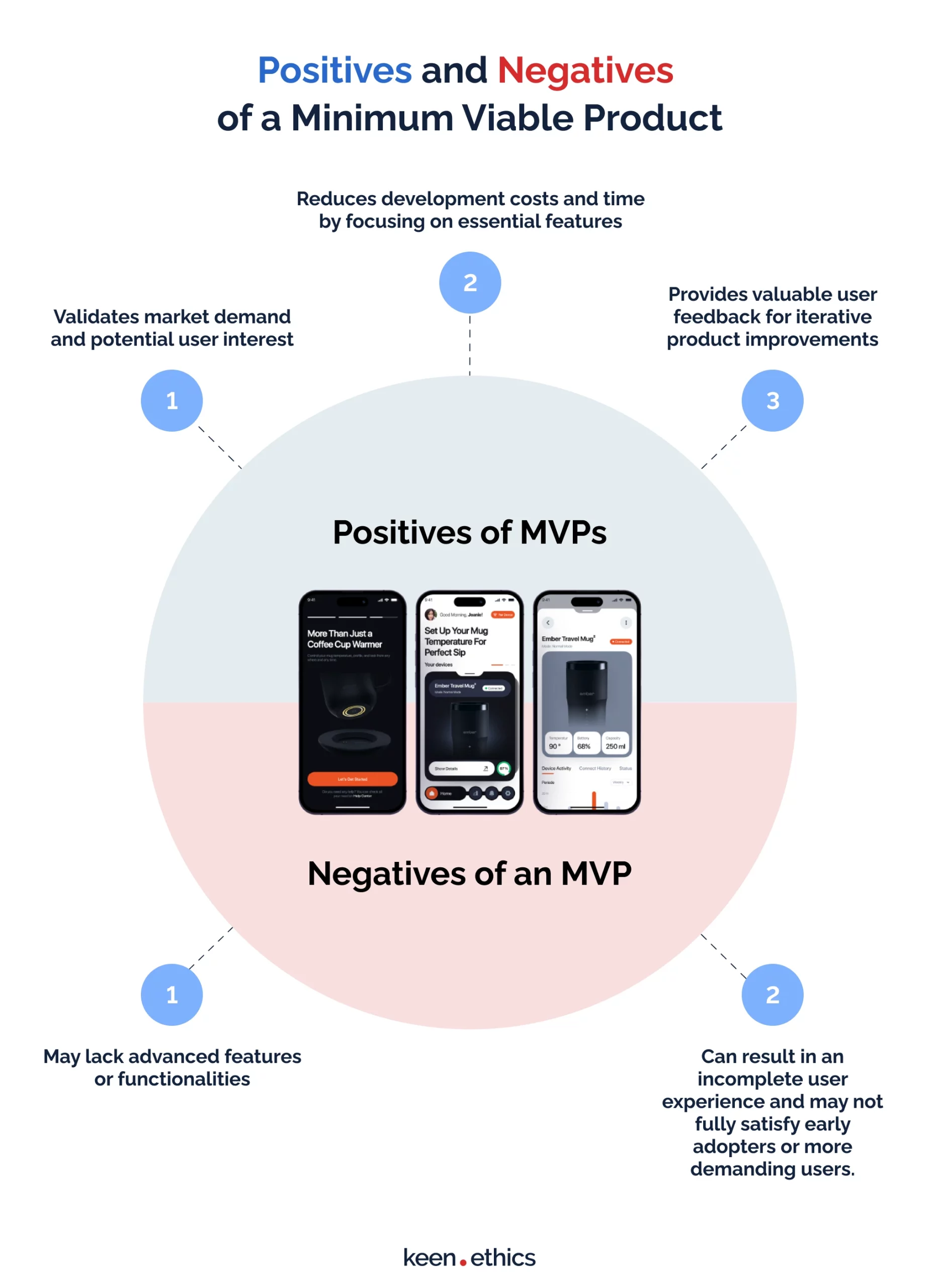
A minimum viable product is a development choice you should consider after the general success of your prototype. What is it? Let’s reiterate the definition: an MVP is the most basic version of a product that contains only its core features and functionalities. What’s the difference between MVP vs. prototype? An MVP is a product aimed at a mass market: it’s a minimal version of the release candidate. So, what are the positives and negatives of an MVP? Let’s look at them!
Positives of MVPs
MVPs offer some long-term positives to the average users:
- Validate market demand and potential user interest
The first reason to use an MVP for your project is the possibility of learning about the market’s reaction. Yes, a prototype can remove many doubts. But, such a framework is still limited to a few people. The MVPs win the prototype vs. MVP contest because it allows seeing how people without business-related expertise react to certain ideas. Smartphones became popular only after Apple tested them on a real audience with the release of the device’s first model.
- Reduce development costs and time by focusing on essential features
The development of a full-scale project is an expensive task. A POC vs. MVP or a prototype vs. MVP are cheaper options. However, they don’t allow testing of a certain idea within the general market. Only an MVP can allow you to reduce development costs and time and deliver a full-scale test of an app in key markets.
- Provide valuable user feedback for iterative product improvements
The prototype phase can spawn many ideas that seem great on paper but don’t work for the market. Let’s return to the aforementioned iPhone example. No one can imagine an iPhone without an AppStore. However, the first model of the product didn’t have one, according to MacRumors. Moreover, Steve Jobs opposed the creation of such side apps and tried to ban user-created open-source app stores for the initial phone version. By creating one of the first minimum viable products in the sector, Apple enabled a rational approach to the evolution of its platform.
Negatives of an MVP
What problems do MVPs have? Here are some of the key issues to consider:
- May lack advanced features or functionalities
Yes, the POC vs. MVP comparison primarily relies on the number of features. This doesn’t, however, mean an MVP offers a full-feature project. The idea here is to create a minimum usable experience. One should add features enabling practical uses. The problem is simple: some users may need more than that. In this light, you risk discouraging potential clients from considering your project. If development is long, one risks creating a negative reputation for the project due to the lack of some key features. Many developers, for example, abandon projects staying in the beta stage for too long: an MVP is a great test tool, but it shouldn’t be a permanent option.
- Can result in an incomplete user experience and may not fully satisfy early adopters or more demanding users.
An MVP may fail at representing the final vision for your project. POC vs. MVP is less advanced. Still, this doesn’t mean an MVP is a project with all features. As we’ve mentioned before, an MVP exists for testing certain ideas. You shouldn’t use it as a long-term business solution. If an MVP is successful, you must move toward the further stages of development as fast as possible.
Examples of Minimum Viable Products
Here are some great examples of Minimum Viable Products:
- Repetition Detector 1: this tool exists to help writers remove common repetitions in their texts by highlighting them. RD1 has minimum features that don’t cover all potential use cases (for instance, it’s impossible to search for specific phrases). This tool, however, enabled the developers to create a much more advanced ‘sequel’ to the project, which allows searching for specific phrases and preserves Microsoft Word editing.
- iPhone (first model): few people would be willing to call the first iPhone a complete product. It was a minimum viable version of a much larger trend. The first iPhone is crucial because it allowed Apple to find flaws in its thinking by delivering features such as AppStore.
Related Services
MVP DEVELOPMENT SERVICES
Comparing a POC vs. Prototype: What Sets Them Apart?
A POC focuses on testing the feasibility or viability of a concept or idea. It aims to validate if something works as intended. Contrary to that, a prototype is an early version or model of a product helping visualize and evaluate its design and functionality. It allows stakeholders to interact with the idea before investing more resources. Prototypes are more tangible and focused on the product itself. Let’s look at an example of POC vs. prototype vs. MVP: current versions of nuclear fusion devices are proofs of concept; the first working generator will be a prototype; the first commercially feasible version will be an MVP.
How Are MVPs and Prototypes Different?
What’s the difference between a prototype vs. an MVP? A prototype exists to test if the project idea makes sense at all regarding usability. The prototype can be expensive and unoptimized. It doesn’t focus on the best user experience but instead offers an approximate understanding of the key features. A smartphone prototype can use an expensive hardware version (due to the lack of effort to optimize its costs). Banking software prototypes may have no vital security features necessary for a full-scale release. In contrast, an MVP is a version of a product that’s ready for the mass market. Its features are minimal, but it’s close to being ready for mass production. An MVP smartphone would have optimized hardware, and a banking app would involve all the key security features.
Proof of Concept vs. Prototype vs. MVP: Selecting the Optimal Strategy
Let’s look at the optimal ways to use a POC vs. MVP vs. prototype:
Why invest in a POC?
Investing in a POC allows businesses to validate the feasibility and viability of a concept or idea before committing significant resources. It helps identify potential risks and challenges early on, enabling informed decision-making. POCs can also attract stakeholders’ interest and support as they demonstrate tangible evidence of a concept’s potential success.
Why invest in a prototype?
Investing in a prototype allows businesses to visualize and evaluate the design and functionality of a product before committing to full-scale development. It helps identify design flaws, user experience issues, and potential improvements. Prototypes also facilitate communication and collaboration among stakeholders, leading to better decision-making and increased chances of success in the final product. While a POC helps with understanding if an idea is feasible, a prototype assists with identifying the pathways to bring it into reality.
Why invest in an MVP?
Investing in an MVP allows businesses to launch a minimum viable version of a product with core features. It helps gather valuable user feedback, validate the value proposition, and identify areas for improvement. By focusing on essential functionalities, an MVP reduces development costs, accelerates time-to-market, and increases the chances of building a successful customer-centric product.
When should I choose a POC?
You should choose a POC when you want to test the feasibility or viability of a concept or idea, especially if technological uncertainties or risks are involved. Proof of concept vs. MVP is notable for the ability to prevent risks at the earliest stage of development.
When should I choose a prototype?
You should choose a prototype when you want to visualize and evaluate the design and functionality of a product before committing to full-scale development or when you need to gather feedback and iterate on the concept.
When should I choose an MVP?
You should choose an MVP to validate the market demand and gather user feedback on a product with its core features. It helps minimize costs, accelerate time-to-market, and guide iterative improvements. MVP vs. prototype vs. POC is notable for allowing developers to analyze the feedback of the general market, one of the most potent decision-making tools available to humankind.
Takeaways
To summarize, the choice of MVP vs. prototype vs. POC primarily depends on your company’s needs. In our opinion, the best development practice is to engage in all those activities at some point. If you’re interested in idea validation and MVP development, Keenethics is here to help. Address us to prepare a high-quality estimate of your project.
FAQs About POC vs. Prototype vs. MVP
How to distinguish between a prototype and a proof of concept?
A prototype is an early product version, while a proof of concept tests the feasibility of an idea or concept.
When should I consider building an MVP?
You should consider building an MVP when you want to quickly validate your product’s value proposition and gather user feedback.
What’s the best option: a POC, a prototype, or an MVP?
In our opinion, everything depends on the situation. A POC is great for understanding if an idea works. A prototype and an MVP help see if its particular manifestation makes sense.
Don’t hesitate to address us: we can help you with validating the key ideas through proofs of concept, prototypes, and MVPs!

